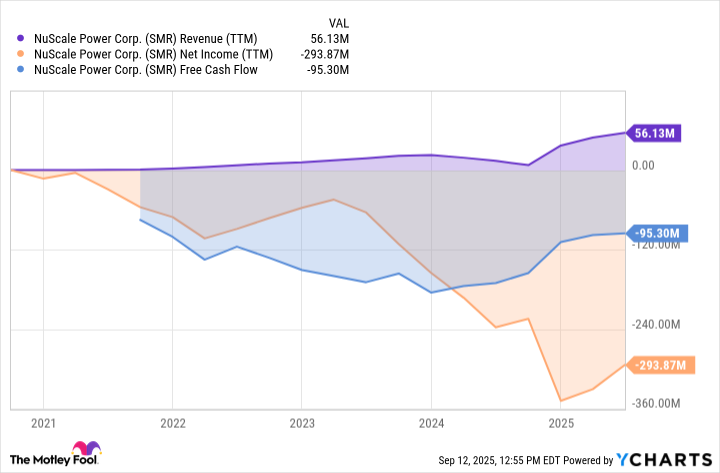Nuclear energy is regaining momentum as countries seek reliable, low-carbon power amid rising energy demands and geopolitical uncertainty. Advanced reactors, public-private investment, and geopolitical pressure to secure energy independence are driving a resurgence.
Small modular reactors (SMRs) offer scalable, flexible nuclear power with enhanced safety and lower up-front costs. Their compact design enables deployment in remote areas or industrial hubs, supporting grid stability and decarbonization.
NuScale Power (SMR 22.11%) is one company developing SMR technology. But it is in its early stages, and a commercially viable product is years away. If you're considering buying NuScale stock, here's what you should know about the business and its longer-term outlook.
NuScale's modular reactors are a promising nuclear technology
After cooling off for several years following the Fukushima disaster in 2011, many countries see nuclear power as a key source of energy to help reduce carbon emissions and meet the growing energy demand from data centers. As of last year, 31 countries have signed a pledge to triple nuclear energy capacity by 2050.
NuScale hopes to play a key role in nuclear power's resurgence. NuScale's core offering, the NuScale Power Module (NPM), is a modular, scalable electric light-water reactor. It can be scaled from one to 12 modules in a single installation, offering customers the flexibility to rightsize their initial investment and expand capacity over time.
NuScale's technology leverages existing light water nuclear reactor technology and conventional low-enriched uranium fuel, which has been in use for over 60 years globally. This contrasts with many other advanced reactor designs that require High-Assay Low-Enriched Uranium (HALEU) fuel, which currently lacks a commercial supply chain and faces national security concerns, potentially delaying commercialization by a decade or more for others.

Image source: Getty Images.
What's next for NuScale?
NuScale doesn't have any commercial products at the moment and isn't generating any revenue from operations yet.
The company is currently performing front-end engineering work for RoPower's 462-megawatt-electric (MWe) power plant in Romania, which is planned to house six NPMs at the site of a decommissioned coal-fired power plant in Doicesti. The RoPower project is currently generating revenue for NuScale through engineering and licensing fees, as well as precommercial operation services. The company hopes this plan is commercially operable by 2030.
Keep a close eye on its finances
NuScale anticipates an increase in operating expenses in the second half of 2025 as it continues to invest in its supply chain and manufacturing readiness in anticipation of commercial contracts.
NuScale aims to maintain approximately two years of operating cash runway and hopes to extend this runway with a major contract. The company currently has $421 million in cash and short-term investments. It has historically incurred significant operating losses.
SMR Revenue (TTM) data by YCharts
Management believes current cash resources are sufficient to cover research and development, along with operating cash needs, for the next 12 months. Still, it acknowledges that additional funds may be required in future years. This could lead to equity raises that ultimately dilute the company's shareholders.
The most immediate and critical item to watch for is the announcement of a firm customer order by the end of 2025, particularly from one of the U.S.-based customers in advanced discussions. This would be pivotal in validating NuScale's product while also providing it with some much-needed cash.
Is NuScale a buy?
I'm keeping a close eye on NuScale and its NPM technology, as it could play a key role in addressing the United States' growing demand for clean energy over the next several decades. The technology has great potential to provide energy independently to data centers, industrial warehouses, or other operators.
With that in mind, it will be several years before the company has a commercial product that produces steady revenue. In the meantime, it will continue to incur costs as it looks to build out its RoPower facility and add more clients. For this reason, I think most investors should avoid the stock for the time being.






